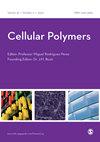Pulverised Flexible Polyurethane Foam Particles as a Filler in Natural Rubber Vulcanisates
IF 1.3
4区 医学
Q4 MATERIALS SCIENCE, BIOMATERIALS
引用次数: 0
Abstract
Polyester polyurethane foam was densified and comminuted using an intermeshing disc impact mill. Resultant particles were investigated as a potential filler in natural rubber at concentrations from 0-75 parts per hundred rubber by monitoring tensile properties, elongation set. cure times and fracture surface characteristics.It was found that a filler concentration of 25 parts per hundred rubber produced essentially similar tensile properties, elongation set and cure time to the natural rubber vulcanisate suggesting that the filler was a satisfactory extender for natural rubber.Increasing filler content to 30 parts per hundred rubber significantly increased modulus at 100% and 200% strain and the ultimate tensile stress but worsened breaking strain and elongation set. Therefore in a critical concentration range between 25 and 30 parts per hundred rubber the particles could be regarded as a reinforcing filler extender whereas higher concentrations produced progressively poorer properties but cheapened the product cost.Scanning electron micrographs of fracture surfaces, obtained at 21°C and after immersion in liquid nitrogen, tended to indicate that reinforcement was likely to be a function of relatively weak intermolecular forces at the interface of the elastomer and the particle, molecular entanglements and a possible further contribution due to the aspect ratio of the particles which may act as short fibre reinforcement.将粉碎的柔性聚氨酯泡沫颗粒作为天然橡胶硫化胶的填料
使用啮合圆盘冲击碾磨机对聚酯聚氨酯泡沫进行致密化和粉碎。通过监测拉伸性能、伸长率、硫化时间和断裂表面特征,研究了天然橡胶中 0-75% 浓度的潜在填充物。研究发现,填充剂浓度为 25 份/百橡胶时,产生的拉伸性能、伸长率和硫化时间与天然橡胶硫酸盐基本相似,这表明填充剂是一种令人满意的天然橡胶扩展剂。将填充剂含量提高到 30 份/百橡胶时,100% 和 200% 应变下的模量以及极限拉伸应力均显著增加,但断裂应变和伸长率却有所下降。因此,在每百分之一 25 至 30 的临界浓度范围内,颗粒可被视为一种增强型填充扩展剂,而更高的浓度则会导致性能逐渐变差,但却降低了产品成本。在 21°C 温度下和浸入液氮后获得的断裂表面扫描电子显微镜图显示,增强作用可能是弹性体和颗粒界面上相对较弱的分子间作用力、分子缠结以及颗粒的长径比可能起到的短纤维增强作用。
本文章由计算机程序翻译,如有差异,请以英文原文为准。
求助全文
约1分钟内获得全文
求助全文
来源期刊

Cellular Polymers
工程技术-材料科学:生物材料
CiteScore
3.10
自引率
0.00%
发文量
9
审稿时长
3 months
期刊介绍:
Cellular Polymers is concerned primarily with the science of foamed materials, the technology and state of the art for processing and fabricating, the engineering techniques and principles of the machines used to produce them economically, and their applications in varied and wide ranging uses where they are making an increasingly valuable contribution.
Potential problems for the industry are also covered, including fire performance of materials, CFC-replacement technology, recycling and environmental legislation. Reviews of technical and commercial advances in the manufacturing and application technologies are also included.
Cellular Polymers covers these and other related topics and also pays particular attention to the ways in which the science and technology of cellular polymers is being developed throughout the world.
 求助内容:
求助内容: 应助结果提醒方式:
应助结果提醒方式:


